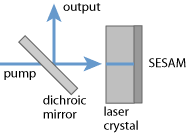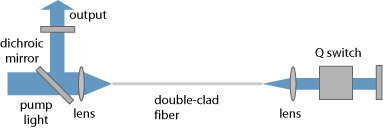OST Photonics offers various functional crystal materials for laser systems, optical equipment and instruments. Crystals are divided into six types according to their functions: laser crystals (diffusion bonding crystals, Nd:YAG, Er:YAG, Yb:YAG, CTH:YAG, Nd:Ce:YAG, Nd:YVO4, Nd:GdVO4, Nd:YLF, Pr:YLF, Ho:YLF, Tm:YLF, Ti:Sapphire, Er:Yb: Glass), nonlinear crystals (KDP & DKDP), KTP, LiNbO3, LBO, BBO, BIBO), passive Q-switch crystals (Cr4+:YAG, Co2+:MgAl2O4), birefringent crystals (YVO4, α-BBO), Magneto-optic Crystals (TGG) and optical crystals (BaF2, CaF2, MgF2, LiF, Germanium single crystal, Sapphire (Al2O3), YAG, ZnSe, Silicon single crystal, ZnS). If you want to know more about our functional crystals, please do not hesitate to contact OST Photonics.
|
AR Coating |
AR/AR @1064nm R≤0.15% |
|
AR/AR @1064nm R≤0.2%&AR@808 R≤0.5% | |
|
AR/AR @1064nm R≤0.2%&AR@532 R≤0.5% | |
|
AR/AR @1064nm R≤0.2%&AR@808 R≤0.5%&AR@1342 R≤1.0% | |
|
Upon customers’ request | |
|
PR Coating |
PR@1064 R or T =? +/-2% |
|
Upon customers’ request | |
|
HR Coating |
HR/HR@1064nm R>99.8% |
|
HR@1064nm R>99.8%&HT@808nm T≥97% | |
|
HR@808nm R>99.8%&HT@1064nm T≥97% | |
|
Upon customers’ request | |
|
P-coating |
P-coating for different wavelength for BBO and LBO etc. |
|
IBS coating |
Upon customers’ request |
|
Mental coating |
Cr-Au, Al and Ag mental coating etc. |
A wide range of functional crystal materials is used in various optical applications. While optical glass is commonly used as a transparent material, different functional crystal materials, primarily monocrystalline materials, are required for diverse applications due to their unique functionalities:
In contrast to glass, birefringent crystals can exhibit birefringence, which is a requirement for various types of polarizers, wave plates, birefringent tuners, and other optical components. Commonly used birefringent crystal materials include YVO4, α-BBO, quartz, calcite and sapphire.
The lattice symmetry of a crystal material is not too high (such as a triangular, quadrilateral, or single prism), and it can exhibit nonlinearity. Nonlinear crystals are primarily used for nonlinear frequency conversion but also find applications in optical modulators like the Pokel cell.
A wide variety of functional crystal materials can be used as laser crystals, serving as host materials for laser-active dopants (rare earth ions or transition metal ions). They typically exhibit relatively high transition cross sections, small gain bandwidth, and good heat conduction compared to laser-active glasses. In general, they also allow for higher doping concentrations.
In some cases, functional crystal materials are used in spectral regions where glass does not have a wide enough wavelength range and high transmittance. In particular, various materials such as zinc sulfide (ZnS), zinc selenide (ZnSe) and Sapphire (Al2O3) are used as infrared crystals, and other materials such as lithium fluoride (LiF), calcium fluoride (CaF2) and magnesium fluoride (MgF2) are used as ultraviolet crystals.
Some functional crystal materials, such as terbium gallium garnet (TGG), exhibit the Faraday effect (polarization rotation caused by magnetic fields), and they can be utilized in devices like Faraday rotators and Faraday isolators.
The pyroelectric effect in some functional crystal materials, such as lithium niobate (LiNbO3) and lithium tantalate (LiTaO3), is exploited in pyroelectric detectors.
The scintillation crystal materials have the capability to detect radiation.
Most optical crystals are insulating (dielectric) materials with wide band gaps and very low absorptivity in the visible spectral region. However, there are also semiconductors that are used as optical crystals, for example as infrared optical crystals, where strong absorption in the visible region is not correlated.
Functional crystals have a wide range of geometric shapes, from simple cubes to cylinders and other shapes with curved surfaces.
DPSS is short name for Diode Pumped Solid State (DPSS) Lasers.
Diode pumped solid-state (DPSS) lasers are solid-state lasers pumped by laser diodes. They emit very short nanosecond pulses with high peak power and repetition rates, while generating minimal heat. These lasers are available in a variety of different wavelengths with very good beam quality. The gain medium of these lasers is glass or crystals doped with impurities, such as neodymium, chromium, erbium, or other ions. This gain medium is placed between two mirror surfaces. The main laser crystals used in this laser are neodymium-doped yttrium aluminum garnet (Nd:YAG), neodymium-doped yttrium orthovanadate (Nd:YVO4) and potassium titanium phosphate (KTP). KTP crystals are sensitive to optical damage at extremely high output levels. DPSS lasers are optically pumped with a diode module with a long life. Because the laser diode has a low noise intensity, the noise of the diode-pumped laser is also very low.

Figure 1: Internal schematic diagram of DPSS laser
DPSS laser is a continuous wave laser that can also operate in pulse mode through a Q-switch. These lasers are very sensitive to temperature. Compared to flash pumped lasers, their design is more compact, the laser head is smaller, and they are very efficient, reliable, and flexible. This type of laser may generate harmonics, allowing wavelengths from ultraviolet to infrared to be emitted. The commonly used DPSS laser is a 532 nanometer green laser. DPSS lasers utilize the narrow linewidth and high brightness characteristics of diode lasers. This leads to maximum absorption, thereby improving efficiency.
Q-switched lasers are laser that uses either active or passive Q-switching technology so that it emits high-energy light pulses. Typical applications of this kind of laser are laser material processing (such as cutting, drilling, laser marking), pumping nonlinear frequency conversion devices, ranging and remote sensing.

Figure 1: Setup diagram of the active Q-switched laser.
Types of Q-switched laser
The most common type is an active Q-switched solid-body laser. Solid gain media are well suited for storing excitation energy for a sufficiently long period of time, and bulk lasers allow for large mode regions (thus allowing higher pulse energy and peak power) and shorter laser resonators (compared to fiber lasers, for example). The laser resonator contains an active Q switch, the light modulator, which in most cases is an acousto-optic Q switch. For emission wavelengths in the 1-μm spectral region, the most common pulsed lasers are based on neodymium-doped laser crystals, such as Nd:YAG, Nd:YVO4, or Nd:YLF, although ytterbium-doped laser gain media can also be used. A small active Q-switched solid-state laser can emit an average power of 100 MW in pulses of 10ns, with a repetition rate of 1kHz and a pulse energy of 100μJ. Then, the peak power is ≈9 kW. The highest pulse energy and shortest pulse duration are achieved at low pulse repetition rates (lower than the inverse upstate lifetime) at the cost of a reduction in the average output power. A slightly larger Nd:YAG laser with a 10W pump source (such as a diode rod) can achieve a pulse energy of several millijoules. Nd:YVO4 is particularly attractive for short pulse durations and high pulse repetition rates, or for operation at low pump power. Q-switched lasers with longer emission wavelengths are typically based on erbium-doped laser gain media, such as Er:YAG at 1.65 or 2.94 microns, or Tulium-doped crystals at ≈2 microns. Significantly greater pulse energy can be obtained from the amplifier system (MOPA). For a combination of high average power and medium pulse energy, fiber optic MOPA, also known as MOFAs, can be used.

Figure 2: Setup diagram of the passive Q-switched laser. The saturable absorber is a crystal inside the laser resonator (e.g. Cr:YAG).
Especially for low pulse repetition rates, lamp pumping is an economically advantageous option, as discharge lamps are much cheaper than laser diodes for a given peak power. However, for higher power, diode pumping becomes more attractive, also because the thermal effect in the laser crystal is greatly reduced.
A passive Q-switched laser contains a saturable absorber (passive Q-switch) instead of a modulator. For continuous pumping, a regular pulse sequence can be obtained in which the pulse repetition rate increases as the pump power increases. The timing of the pulse cannot usually be precisely controlled by external means. The most commonly used saturable absorber for 1-μm lasers is the Cr:YAG crystal.

Figure 3: Microchip laser, passive Q switching with SESAM. The left side of the laser crystal has a dielectric coating that acts as an output coupling mirror.
Passive Q-switched microchip lasers have a particularly compact setup. Such lasers typically emit pulses of energy between nanojoules and a few microjoules, with an average output power of tens of milliwatts and a repetition rate between several thousand Hertz and several megahertz. In general, the average output power of passive Q-switched lasers is more limited than that of active Q-switched lasers, because the saturable absorber dissipates some energy, so there is a limiting thermal effect. Note that saturable absorbers usually have some non-saturable loss, which tends to dissipate much more energy than is unavoidable in principle. In particular, some smaller Q-switched lasers, but there are also some lasers with longer resonators that contain an optical filter, such as a volume Bragg grating, operating on a single axial resonator mode. This results in a clean time shape and a small optical bandwidth, usually limited by the pulse duration. Other lasers oscillate over multiple resonator modes, which results in a mode jitter effect: the output optical power is modulated at a frequency that is an integer multiple of the resonator's round-trip frequency. Fiber lasers can also be Q-switched either actively or passively. However, the performance of all-fiber devices is quite limited, while Q-switched fiber lasers that contain bulk optical components such as acousto-optic Q-switches (see Figure 4) are less robust and still less powerful than bulk lasers. The relatively small mode area (even when using large mode area fibers) presents problems of fiber nonlinearity and laser-induced damage, which sets limits on the pulse energy, especially the peak power that can be achieved. It should also be noted that the usually very high laser gain in fiber lasers has an important effect on laser dynamics; In particular, it may lead to the formation of complex temporal substructures.

Figure 4: Setup of an active Q-switched fiber laser.
On the other hand, high-power fiber amplifiers are suitable for amplifying pulse train with high average power but moderate pulse energy. In such amplifiers, a certain degree of nonlinear pulse distortion is often acceptable for applications.
Q-switched lasers have a wide range of applications:
1. Laser material processing, such as laser cutting, laser drilling, laser marking, laser pattern, etc.
2. Laser rangefinder
3. LiDAR for 3D imaging
4. Laser-induced breakdown spectroscopy
5. Medical applications, such as dermatology and tattoo removal
6. Pump equipment for nonlinear frequency conversion, such as pulsed optical parametric oscillator
7. Fluorescence spectroscopy